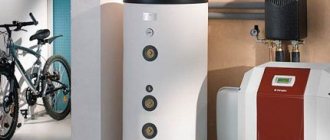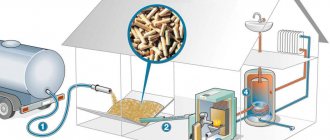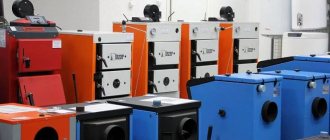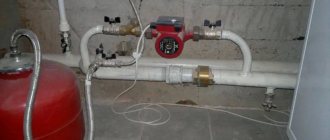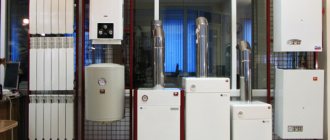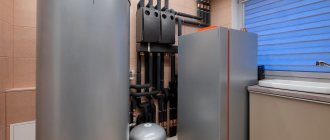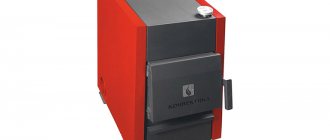Properly choosing boilers for heating a private home is necessary for installing an autonomous system. It is heating equipment that will provide housing with heat and hot water. It will create the microclimate necessary for human habitation. In addition, it will work flawlessly. It is so?
We will tell you how to buy a boiler that will meet your requirements and wishes. We have analyzed all the criteria that you should pay attention to when looking through catalogs of online stores or an assortment of specialized retail outlets. Problems that you may encounter before and after purchase are listed.
Basic criteria for choosing boilers
Hundreds of foreign and domestic manufacturers offer thousands of models of heating equipment. It is not easy for an unprepared buyer to navigate all this variety of products. I want it to be cheaper and the quality to be high.
All heating boilers differ in the type of fuel and are divided into the following categories:
- solid fuel (processing firewood, peat, pellets, coal);
- liquid fuel (units running on diesel fuel);
- gas (regular and condensing);
- electrical (requiring electricity supply);
- universal (using either gas or electricity).
Before choosing an option, it would be a good idea to do a little analysis and find out which energy carrier is profitable to use in your region. Then you need to decide how safe, reliable and comfortable the boiler should be in terms of every penny invested in it.
You need to choose one or another type of heating equipment after first familiarizing yourself with the advantages and disadvantages of each of them.
In order not to make a mistake and not waste your hard-earned money, you need to carefully consider the process of choosing equipment. To do this, it is necessary to take into account a number of nuances that significantly affect the final result.
When choosing a boiler you should:
- understand in detail the advantages and disadvantages of each type of boiler;
- calculate the optimal heating power for your home;
- decide on the number of circuits;
- choose the location where the equipment will subsequently be placed.
The maximum permissible dimensions and weight depend on the future location of the boiler. After all, for a small room it is not advisable to choose a heavy cast iron unit.
The choice of heating equipment must be approached responsibly. This is the only way to buy high-quality equipment that will last for many years.
Rules for calculating equipment power
It’s worth remembering right away that the desire to save money on designing a heating system and performing thermal calculations in most cases backfires on the customer. If you think through everything carefully and trust a highly qualified specialist, then the cost of the boiler, radiators and other equipment will be much cheaper.
The power of the heating boiler is selected to calculate the distribution of approximately 0.1 kW per m2 of living space
To approximate the power of heating equipment required to heat a building and provide hot water supply, you can use special design standards.
It is also imperative to take into account:
- the number of people who will live in the house;
- building materials used for housing construction;
- climate zone;
- number of windows and doors;
- number of floors and other factors.
The opinion that the boiler power is selected at the rate of 0.1 kW per square meter is quite common. But thanks to modern building materials and innovative engineering equipment, heat losses can be significantly lower and, accordingly, the performance of heating equipment can be higher.
Features of single- and double-circuit boilers
When thinking about how to choose the right heating boiler for your home, special attention should be paid to such a characteristic as the number of circuits. Single-circuit technology is intended exclusively for heating the coolant circulating through heating pipes.
A single-circuit boiler is designed to serve only one system: either hot water supply or heating. If it is not possible to install a double-circuit unit, it is permissible to use no more than two boilers in one boiler room, regardless of their floor or wall-mounted design
In this case, to heat tap water you will have to additionally install a boiler. Yes, a single-circuit boiler is convenient, but the disadvantage of this solution is its high cost - you will have to buy not only heating equipment, but also a boiler. Moreover, both devices will take up a lot of space.
As for the double-circuit boiler, here the heating equipment and water heater are assembled into a single structure. Thanks to this structure, you can solve two problems at once, while purchasing only one unit.
In addition, in the absence of hot water, the coolant can be redirected to the second circuit and used alternately - to heat the house and to provide hot water supply.
Operating principle of single-circuit equipment
Single-circuit heating equipment is most often used by owners of luxury country houses. In essence, a single-circuit boiler is the same water heater, but supplies water to the heating system.
The operating principle of this type of equipment is based on burning fuel in a special compartment and heating the liquid. The heating main is connected to the outlet where the hot coolant enters. Next, the water begins to circulate through the pipes and heat the rooms.
The final stage of circulation is the flow of waste coolant back into the boiler through the inlet pipeline.
If you do not need to provide hot water supply, then it is better to give preference to single-circuit boilers
The cost of a single-circuit boiler may be more than a double-circuit system. Even despite less functionality, this type of equipment is less expensive to install, easier to operate and more energy efficient.
Single-circuit equipment is suitable for those buyers who want to spend money once and buy reliable equipment that does not require special care. This type of boiler will be the ideal and only right choice when there is no need for hot water supply in the house.
Design specifics of a dual-circuit unit
A double-circuit boiler is a system where, in addition to the primary heat exchanger, there is an additional one designed to heat water and then supply it to the water supply system. The movement of the coolant is controlled using a three-way valve. It directs the heated water either to the DHW circuit or to the heating system.
It should be noted that in the first case, the coolant will be supplied only if the hot water tap has been opened. The peculiarity of such heating equipment is that while the tap responsible for supplying hot water is open, the system does not work.
If you have a large family and some of its members like to take long showers, then the rooms may become cool. Manufacturers solve this problem by installing a storage water heater in their boilers.
The disadvantages of the double-circuit boiler design include the need for careful and attentive maintenance. This is due to the fact that the secondary heat exchanger can become overgrown due to the use of water containing organic and mineral particles suspended in it, and the small diameter of the pipes.
If you plan to actively consume hot water, then installing a double-circuit boiler is not the best solution. After all, then the house will not be heated well. You should only think about installing this system in a small house or apartment, where there is not enough space to organize a full-fledged boiler room.
Furnaces with a water circuit - 3 varieties
To implement stove heating combined with the radiator system of a private house, 3 types of stoves with a water circuit are used:
- metal - steel and cast iron stoves with a built-in coil for heating the coolant;
- fireplace inserts with a heat exchanger - water jacket;
- heating and cooking stoves made of brick with a built-in boiler.
Note. Potbelly stoves for baths, equipped with a tank and a coil, are structurally similar to the listed units. It is theoretically possible to adapt a sauna stove for the needs of steam heating, but it is too troublesome and inconvenient from the point of view of operation.
Pipes filled with water pass over the flame and receive maximum heat.
This also includes an alternative option - steel wood-burning heaters, made by yourself. Such products deserve attention because they are not inferior to factory ones in terms of reliability and heat transfer, but they are much cheaper. The appearance of a potbelly stove does not always play an important role.
We propose to consider the stoves of each group separately, focusing on the disadvantages and advantages that are important for the homeowner.
Disadvantages of metal potbelly stoves
In factory-made wood stoves, the coolant is heated in three ways:
- A water-tube heat exchanger is installed in the upper zone of the firebox or near the flue gas outlet.
- One of the walls of the combustion chamber (top or side) is in contact with a water layer, reminiscent of the jacket of a solid fuel boiler.
- Several coolant pipes go around the semicircular walls of the firebox. The ends are welded from below and above into common collectors, as shown in the drawing.
Modification of the convective heater "Breneran" (analogue of the well-known "Buleryan") with a water-tube heat exchanger
Reference. An example of a product with a partial water jacket is the Termofor Hydraulic house heating stove, with side pipes - converted Breneran-Aquaten convection heaters.
Manufacturers often supply stoves with an additional heater - a heating element with a power of 1...15 kW. The goal is to maintain the temperature of the coolant and air in a private house after a portion of solid fuel burns out. Some models are equipped with a hob with 1-2 burners.
The real advantage of metal heating units is the low cost of the product and speed of installation compared to laying a brick oven. Example: the price of a 3.5 kW Breneran-Aquaten heater is approximately 270 USD. e. (without chimney). When installing a potbelly stove with your own hands, you will spend another 50-100 USD. e. on materials used for installation and strapping.
The Hydraulic series of heaters from the famous Termofor brand are equipped with a water jacket and pipes surrounding the firebox
Comment. The cost of the chimney pipe required for any stove is not taken into account. The price greatly depends on the lifting height, channel design and laying pattern.
Now let's look at the disadvantages:
- no matter what manufacturers and sellers claim, the maximum efficiency of air-water stoves using wood and coal is 60%;
- the unit heats up and cools down equally quickly;
- the heat exchanger is usually enough to heat 2-3 small rooms (1 radiator in each);
- The water circuit needs a circulation system.
It is not easy to maintain cleanliness and beauty around the stove, which serves as the main source of heat in the house
. Let us clarify the last point. If the flow of water through the coil stops, the element will overheat. First, the coolant will boil, then evaporate and break the nearest weak connection. Later, the heat exchanger will burn out and finally fail.
To be fair, let us mention the issue of aesthetics. By constantly using a potbelly stove to heat your home, you will not get the beautiful picture that manufacturers like to show in the photo. The stove will quickly become dirty, wood and coal dust will appear in the room, and the smell of smoke will appear.
Fireplace inserts - pros and cons
A rectangular stove with a water circuit, made in the form of a fireplace, is structurally much closer to a TT boiler. The side walls of the fuel chamber are washed with coolant, the front and top parts heat the air in the room. The bottom receives little heat, so it is not taken into account.
Positive aspects of fireplace inserts equipped with a water heat exchange jacket:
- fuel combustion efficiency – up to 70%;
- reasonable cost (compared to brick buildings);
- simple and quick installation;
- A fireplace stove equipped with a transparent door will fit perfectly into the interior of a living room.
Reference. The Termofor Aquarius fireplace water insert with a heat output of 12 kW will cost 530 USD. e. It is difficult to estimate additional costs; their value depends on the method of decorating the fireplace. Budget option: place the heater on a solid base, connect it to the radiator network, and do the finishing yourself or put it off until later.
The boiler tank surrounds the combustion chamber on the sides and partially on top.
The disadvantages of metal fireboxes are similar to the disadvantages of furnaces:
- the fireplace heats up and cools down quickly and requires continuous circulation of the coolant;
- provides heat to a limited number of batteries;
- due to temperature changes, condensation forms on the internal walls and soot deposits are deposited;
- complete resemblance to a natural fireplace is achieved through design - decorative brickwork or plasterboard sheathing.
When using a fireplace insert as the main source of thermal energy, do not count on long-term combustion from 1 start. Example: the useful volume of the combustion chamber of the aforementioned Aquarius is only 62 liters, but it will not be possible to completely fill the firebox with firewood. You will have to add logs every 3-4 hours.
Over time, the walls of the firebox become covered with soot, and the panoramic glass becomes covered with soot.
Note. Most steel stoves suffer from a similar drawback - in intense combustion mode, you just have time to throw in some firewood.
Strengths and weaknesses of brick heaters
Heat exchangers are installed inside the stove in two ways - in the firebox or in the flue, along the path of the hot combustion products. Each option has its own nuances:
- the boiler in the combustion chamber quickly warms up under the influence of the flame, but forms condensation and soot on the walls;
- in the event of boiling and steam formation, the tank may rupture right in the firebox and destroy the brickwork;
- the heat exchanger inside the smoke circuits is much safer, but heats up more slowly because it receives less heat.
Reference. The coil placed in the flue must have twice the heat exchange area than a boiler in the firebox of comparable power.
Location of the water circuit inside the combustion chamber (left) and chimney channels (right)
The main disadvantage of any brick heater is the high cost of materials and masonry work. Suppose you decide to save money and build the stove yourself. This will require experience, time and technical capabilities - starting construction in the middle of a habitable house is not easy. The best option is to lay the foundation and furnace at the stage of wall construction.
Why are stone stoves with a built-in heat exchanger valued:
- service life is incomparably longer than any heat generator - at least 50 years;
- the ability to accumulate heat and heat adjacent rooms for a long time after extinguishing;
- maximum efficiency – 70…75%;
- in a heated stove, the soot that forms on the walls of the tank and in the chimney burns out well;
- some brick stoves - Dutch duct, Swedish, Kuznetsov's bell-type stove - can easily heat a two-story house.
Interesting fact. A water heater section can be added to any brick stove. Smart stove makers know how to change the layout and procedures to install a heat exchange water register.
Selecting a location for heating equipment
All types of heating boilers are produced mainly in a floor-standing version, electric in a wall-mounted version, and gas in both a wall-mounted and a floor-mounted version. The latest variation is best installed in a spacious separate room. Such heating equipment is characterized by great power and massiveness.
A wall-mounted boiler will be an ideal solution for small-sized houses, where every square meter counts
And due to the fact that the weight of floor-standing boilers is not limited in any way, manufacturers install a cast-iron heat exchanger in it, which is much more reliable than a steel one.
Wall-mounted heating equipment is compact in size and fairly light in weight. But this type of boiler is limited in power. This minus is especially relevant for dual-circuit systems - the performance of the heating circuits will be quite low.
You should choose wall-mounted boilers only if the heated area does not exceed 200 m2 and the hot water consumption is no more than 14 l/min. If the needs are greater, then it is better to give preference to the floor-mounted variation of heating equipment.
It should be noted that many buyers, regardless of the size of their living space, prefer floor-mounted systems that are equipped with a cast-iron heat exchanger. After all, such devices are less demanding on the quality of power supply.
Solid fuel options
The second most popular type of boiler for a summer residence is solid fuel. Finding a source for ignition is not so difficult; they often use firewood prepared in advance or buy coal.
In Russia, the most popular and in demand is the inexpensive model of the heating boiler Teplodar Kupper OK 20. Its main characteristics:
- single-circuit boiler with an open combustion chamber;
- maximum power 20 kW, which is enough for an area of 200 m²;
- works on wood, coal, pellets, gas and liquefied gas;
- floor installation with a chimney diameter of 15 cm.
Consumers note the convenience of using different types of fuel, including gas, which allows them to use brought cylinders and then switch to wood or coal if necessary. There is a built-in safety system that protects the boiler from overheating. And one circuit is enough to heat a country house without supplying hot water.
If you need a long-burning solid fuel boiler, you should purchase the reliable domestic model Stropuva S20P with a power of 20 kW and one circuit. Works only on wood or coal and is installed on the floor. Such equipment is perfect for city residents who come to their dacha only on weekends or on vacation.
Subtleties of using boilers
The vast majority of boiler models require electricity to function properly. The only exception is solid fuel heating equipment that burns coal or wood. Such devices can work autonomously.
Why is electricity needed? Current is required for the operation of the boiler system automation and its pumps. Therefore, a good solution would be to order an electric generator along with the heating equipment. This solution is especially relevant for those regions where the power is often turned off.
When organizing a boiler room, special attention should be paid to the chimney to ensure proper operation of the equipment and safety during its use
Regardless of the type of boiler used, the manufacturer does everything possible to ensure that the operation of its equipment is as safe as possible.
Therefore, almost any modern model of heating equipment is equipped with the following protection systems:
- a sensor that detects the presence or absence of a flame;
- traction control sensor;
- a device that will stop the operation of the boiler if the pressure in the gas pipeline drops below the permissible level;
- a device that turns off the boiler in the event of a lack of electricity;
- a system that protects equipment from overheating;
- a sensor that stops the operation of heating equipment in the event of a decrease in the volume of coolant.
All the details listed above are the bare minimum that will protect the boiler from breakdowns and the home itself from fire.
As for the location of the equipment, certain models of boilers, the boiler power does not exceed 100 kW, can be installed directly in the kitchen.
Other types of heating equipment must be placed in a specially equipped room of a certain cubic capacity, with a thoughtful and well-designed ventilation system, with fire safety devices, etc.
The organization of a boiler room must be approached with all responsibility and must comply with all recommendations of specialists, as well as fire safety standards
The most commonly used boilers in the CIS countries at present are gas boilers. This demand is explained by the low cost of this energy carrier, as well as the reliability and durability of boilers of this type. But due to regional characteristics, gas heating equipment is not always the most optimal and profitable solution.
You need to choose heating equipment depending on your personal wishes and needs, the size of your living space and the availability of energy.
Economical fuel consumption and reduction in equipment maintenance costs are an important component of choosing the optimal unit for an independent heating system. The rules for organizing energy-saving heating are given in our recommended article.
Heating system of a private house
For the conditions of a country house, water heating is the most suitable. Fundamentally, this heating system consists of a boiler of the required power, piping and batteries. Water circulates in the system, which does not need to be removed at the end of the season. The coolant can move through the system naturally or forcefully.
Forced circulation
The design of the heating system includes a pump necessary to supply water to the boiler and, after heating, its further movement through the system. The operation of modern equipment is fully automated, so human participation in its operation is minimized. The use of this system makes it possible to create efficient heating of multi-storey buildings.
Coolant circulation system
Natural circulation
The movement of the coolant when using this system occurs due to the movement of layers of liquid having different densities in the cold and heated states. The implementation of water movement in this way becomes possible if there is some inclination of the pipeline. It is possible to achieve high-quality heating in this way if the building has one floor.
Single pipe system
In principle, the single-pipe piping scheme is very simple. Water is supplied through one system, which is a closed circuit. It is a heating boiler connected to heating appliances. Moreover, the piping occurs through one circuit having one riser. The latter connects all elements of the system in series. A pump can be used to create pressure to move the coolant. The design of a single-pipe system can be vertical or horizontal.

